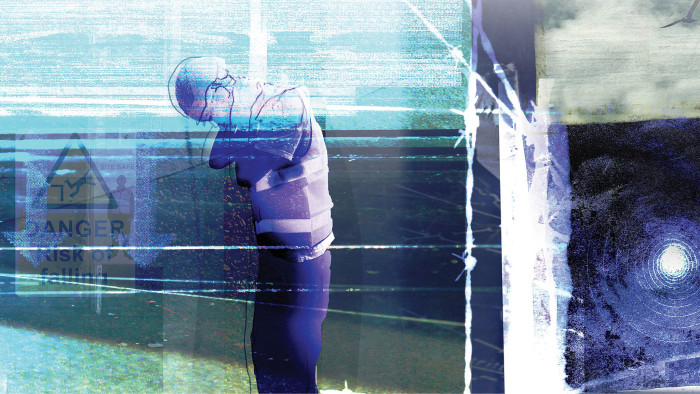It is hard to talk about suicide, but employers must

Roula Khalaf, Editor of the FT, selects her favourite stories in this weekly newsletter.
Michael Mansfield finds that addressing employers about suicide prevention is a way of “channelling the feelings, the anger”. The eminent English barrister’s daughter, Anna, committed suicide in 2015. “I can’t get to grips with it,” he says.
The reasons for suicide are complex and personal. But Mansfield believes employers should do more to help employees at risk. There is “a collective responsibility”, he says. In his daughter’s case, her mental health deteriorated after she was made redundant. While Mansfield knows that his daughter’s decision to take her own life was complicated — Anna also had two young children with health problems — he believes that employers should be vigilant about trying to detect signs of distress in employees, whether they are secure in their role or about to be made redundant.
“Companies are not alive to personnel issues,” he says. “Employees require a place where they feel comfortable talking about their difficulties. [People with mental health problems] worry that if they reveal vulnerabilities to line managers they will get chucked out.”
Louise Aston, wellbeing director at Business in the Community, a UK charity, agrees. She says few companies feel comfortable talking about suicide. This means they are neither good at talking to those who may be at risk nor do they know how to care for the workforce if an employee kills him or herself. “The biggest mistake is that companies are reactive,” she says, whereas she believes they should have policies in place in such circumstances.
If an employee takes his or her own life it is not necessarily a sign they worked for a bad employer, she says. “But a responsible employer . . . should have mental health policies embedded into the organisational culture.” This is particularly important because people with suicidal thoughts are not necessarily in touch with mental health services and might continue to turn up at work, even as their feelings intensify.
4% of employees would not be willing to discuss a mental health issue with anyone. 21% of those employees have moderate to severe depression
VitalityHealth/Rand Europe; Britain’s Healthiest Workplace
Talking about mental health is less of a taboo than it was, but the stigma around suicide is still strong, says Aston. Rachel Suff, employment relations adviser at the UK’s Chartered Institute of Personnel and Development, agrees: “I’ve heard mental health discussed as part of corporate policy but rarely suicide. We need more openness.”
To improve matters, some suggest companies need to tell staff, particularly line managers, what signs to look for (see box, below). Poppy Jaman, chief executive of Mental Health First Aid England, a mental health training provider, believes colleagues and managers should be trained to observe changes in people’s behaviour. In a recent report, she wrote: “We teach people that if they are concerned about someone, not to be afraid to ask the question, ‘Are you having suicidal thoughts or feelings?’, because if they are, then they can be supported to access the right professional help and quickly.” Contrary to popular mythology, she says, talking about suicide does not encourage people to take their own life. It could, however, be the first step towards prevention.
There are some occupations that experience higher suicide rates than others. The Office for National Statistics (ONS), published a report earlier this year, that showed that between 2011 and 2015 the suicide rate in England among males aged between 20 and 64 years was 18.9 deaths per 100,000. Men working in the lowest-skilled occupations, had a 44 per cent higher risk of suicide than all men.
In Australia, according to Mates in Construction, an organisation that looks at mental health in the industry, construction workers are six times more likely to die from suicide than from an accident at work.
A study published in Psychological Medicine (2013) found that socio-economic forces are a major determinant of high occupational suicide rates in Britain. It identified those in mainly manual occupations, such as merchant seafaring, labouring in building trades and window cleaning, as being particularly at risk. Those sectors of the labour market had “undergone major contraction and reconfiguration, particularly during the 1980s, resulting in the loss of traditional patterns of employment in some communities, which may have affected suicide rates for these occupations”. The authors suggested the high suicide rates were partly due to difficulties adjusting to change and handling stress.

As employment has become more precarious, organisations might also need to consider the mental wellbeing of contractors. “The structure of the workplace is changing. If you are at a distance from the office, organisations need to think about how to assess people’s mental health,” says Suff.
Samaritans, the UK charity, said in a 2012 report that middle-aged men from disadvantaged socio-economic backgrounds were highest risk because they were less likely to talk about their feelings.
“Problems with relationships and employment during mid-life are experienced intensely, because by this life stage people have typically invested a great deal in work and relationships, and the possibilities for making changes in these areas are limited,” the report said.
It identified the current generation of men in their mid-years as “the buffer generation — caught between the traditional silent, strong, austere masculinity of their fathers and the more progressive, open and individualistic generation of their sons”.
There is a difference between the genders. The authors of the study in Psychological Medicine wrote: “More of the high-risk occupations among women than men were professional or non-manual rather than manual, which suggests that socio-economic forces are a stronger determinant of occupational suicide rates among men than among women.” The ONS found that among women the risk of suicide was highest in artistic, literary and media occupations.
Employers should think not just of prevention of suicide but also so-called “postvention” — strategies to support employees if a colleague has died through suicide. “My estimation is not many employers have protocols in place,” says Aston.
The impact of suicide on co-workers may be profound. “It can be a shock. People who kill themselves may not have shown signs. People will feel deep guilt about what they could have done to prevent it,” says Aston. She stresses that the reasons someone might decide to kill themselves are very complex. “Suicide is a feeling of unbelievable pain.” The reasons that someone chooses to die “can never be fully known”.
11.6% of people aged 18-20 suffer from depression. 2.1% of people aged 56-60 suffer from depression
VitalityHealth/Rand Europe; Britain’s Healthiest Workplace
Suff says that if a suicide happens to a colleague, it “can be completely devastating” for their peers at work. But if employers have a framework in place and can support employees, the distress can be somewhat alleviated.
Employers will need to be mindful of employees’ divergent ways of reacting and perhaps try to decrease workloads, and allow time off. A suicide prevention “toolkit” published by Business in the Community, a charity supporting ethical business practices, and Public Health England suggests managers should make themselves available to employees, including those who work remotely. It gives guidelines on memorial services, advising employers to commemorate the life of the deceased rather than dwelling on their death.
Line managers might be particularly affected and become the target of recriminations from colleagues, but managers can also be role models, talking of their methods of coping, occupational health experts say. The important thing is to communicate. If the workforce feels valued in the wake of a suicide, it can help them manage their own feelings but also foster trust in their leaders. A vacuum can have the opposite effect, destabilising the workforce and destroying trust. “It is a crisis,” says Suff. “You have to try to manage a crisis and support colleagues.”
Signs that someone is suffering with their mental health
1. Changes in productivity
- Deterioration in performance at work
- Lethargy in a previously energetic person
- New pattern of unexplained lateness or absences
- Recent inability to concentrate on work
- Recent inability to complete work
2. Changes in social functioning
- Deterioration in social functioning
- Withdrawal from colleagues, isolation
3. Changes in personality or behaviour
- Extreme mood swings
- Acting anxious or agitated
- Showing rage, uncontrolled anger
- Behaving recklessly
4. Increased alcohol or drug use
5. Changes in eating and sleeping patterns
6. Signs of (self-inflicted) physical harm
Source: Business in the Community/Public Health England, Reducing the Risk of Suicide: A Toolkit for Employers
Comments